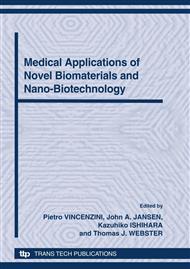p.207
p.214
p.224
p.229
p.235
p.240
p.247
p.253
p.259
Role of Grain Size Fluctuations on the Environmental Resistance of Alumina-Zirconia Composite in Comparison with Commercially Available Monolithic Zirconia Femoral Head
Abstract:
Raman microprobe spectroscopy and atomic force microscopy (AFM) were systematically used to characterize the surface of an advanced alumina/zirconia composite (henceforth also referred to as zirconia toughened alumina, ZTA), in comparison with a commercially available femoral head made of monolithic zirconia. Experiments were conducted before and after in vitro exposure in water moist environment up to 100 h. Both materials contained zirconia partly stabilized with yttria. Tetragonal-to-monoclinic phase transformation, which was quantitatively characterized by confocal Raman spectroscopy as a function of grain size, showed significant difference between the investigated samples. Such difference was similarly found with respect to both roughness level and time needed for such topologic changes to occur. Variation of phase fractions and of topologic surface parameters were plotted as a function of in vitro exposure time and compared.
Info:
Periodical:
Pages:
235-239
Citation:
Online since:
October 2010
Authors:
Price:
Сopyright:
© 2010 Trans Tech Publications Ltd. All Rights Reserved
Share:
Citation:


